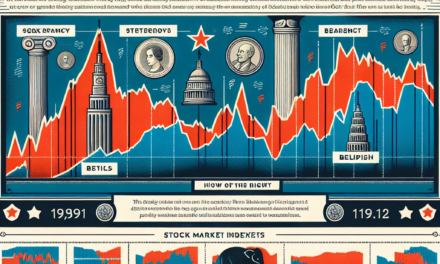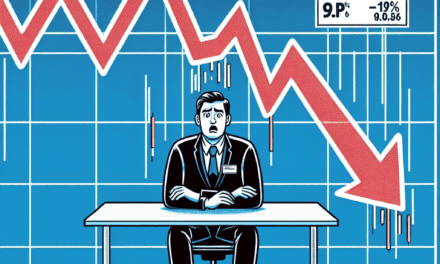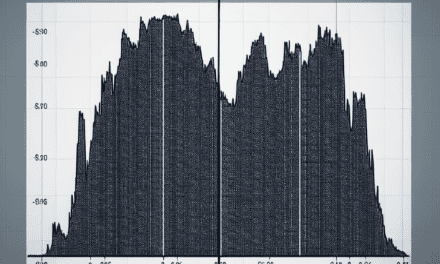“Steady Stocks, Softer Dollar: Navigating Post-Election Market Waves”
Introduction
Following a period of heightened political uncertainty, global stock markets have managed to sustain their post-election gains, buoyed by a weakening U.S. dollar. Investors are closely monitoring the evolving economic landscape, as the softer dollar enhances the appeal of equities by making American goods more competitive abroad and boosting the earnings of multinational companies. This market resilience reflects a cautious optimism among investors, who are balancing the potential for economic recovery with ongoing geopolitical and fiscal challenges. As the dollar’s decline continues to influence market dynamics, stakeholders are keenly observing central bank policies and fiscal measures that could further impact currency valuations and equity performance.
Impact Of Post-Election Stability On Stock Market Performance
In the wake of the recent elections, the stock market has demonstrated a remarkable resilience, maintaining its gains as investors navigate the evolving economic landscape. This post-election stability has been a significant factor in bolstering market confidence, as the political clarity provided by the election results has alleviated some of the uncertainties that typically weigh on investor sentiment. As a result, stocks have continued to perform well, reflecting a broader sense of optimism about the future economic outlook.
One of the key drivers of this positive market performance has been the softening of the U.S. dollar. A weaker dollar generally benefits multinational corporations, as it makes American goods and services more competitive abroad, thereby boosting export revenues. This dynamic has been particularly advantageous for large-cap companies with significant international exposure, as their earnings prospects have improved in light of favorable currency exchange rates. Consequently, sectors such as technology and consumer goods, which have a substantial global footprint, have seen notable gains.
Moreover, the post-election environment has ushered in a period of relative political stability, which has been welcomed by investors. The resolution of electoral uncertainties has allowed market participants to refocus their attention on economic fundamentals and corporate earnings, rather than being preoccupied with potential policy shifts. This renewed focus on fundamentals has been instrumental in sustaining the upward momentum in stock prices, as investors have been encouraged by strong corporate earnings reports and robust economic data.
In addition to the domestic factors at play, global economic conditions have also contributed to the favorable market environment. The easing of geopolitical tensions and the gradual recovery of major economies from the pandemic-induced downturn have provided a supportive backdrop for equities. As global trade and investment flows continue to recover, companies with international operations are poised to benefit, further underpinning stock market gains.
However, it is important to note that while the current market conditions are favorable, potential risks remain on the horizon. Inflationary pressures, driven by supply chain disruptions and rising commodity prices, pose a challenge to sustained economic growth. Central banks around the world are closely monitoring these developments, and any indications of a shift in monetary policy could have significant implications for financial markets. Investors, therefore, remain vigilant, balancing their optimism with caution as they assess the potential impact of these factors on future market performance.
Furthermore, the ongoing evolution of the global economic landscape necessitates a careful consideration of investment strategies. Diversification remains a key principle for managing risk, as it allows investors to mitigate potential losses by spreading their investments across different asset classes and geographic regions. By maintaining a diversified portfolio, investors can better navigate the complexities of the current market environment and position themselves to capitalize on emerging opportunities.
In conclusion, the post-election stability has played a crucial role in sustaining stock market gains, supported by a softer dollar and improving global economic conditions. While the outlook remains positive, investors must remain cognizant of potential risks and continue to adopt prudent investment strategies. As the market continues to evolve, maintaining a balanced perspective will be essential for navigating the challenges and opportunities that lie ahead.
How A Softening Dollar Influences Global Stock Markets
In the wake of recent elections, global stock markets have experienced a notable upswing, buoyed by a softening U.S. dollar. This phenomenon has sparked considerable interest among investors and analysts alike, as the interplay between currency fluctuations and stock market performance becomes increasingly evident. Understanding how a weakening dollar influences global stock markets is crucial for investors seeking to navigate the complexities of international finance.
To begin with, a softening dollar can have a profound impact on multinational corporations, particularly those based in the United States. When the dollar weakens, U.S. exports become more competitively priced on the global stage, thereby boosting the revenues of American companies with significant overseas operations. This, in turn, can lead to an increase in stock prices as investors anticipate higher earnings. Consequently, the stock market often reflects this optimism, with indices such as the S&P 500 and Dow Jones Industrial Average showing gains.
Moreover, a weaker dollar tends to make U.S. assets more attractive to foreign investors. As the dollar depreciates, the relative cost of investing in U.S. stocks decreases for those holding foreign currencies. This influx of foreign capital can drive up stock prices, further contributing to the post-election gains observed in the market. Additionally, the softening dollar can lead to increased demand for commodities priced in dollars, such as oil and gold, as they become cheaper for holders of other currencies. This can have a ripple effect on related sectors, such as energy and mining, which may see their stock values rise as a result.
Transitioning to the global perspective, the impact of a softening dollar extends beyond U.S. borders. Emerging markets, in particular, stand to benefit from a weaker dollar. Many of these economies rely heavily on dollar-denominated debt, and a depreciating dollar reduces the burden of these obligations, freeing up resources for growth and investment. As a result, stock markets in emerging economies may experience a boost, as improved economic conditions translate into higher corporate earnings and investor confidence.
Furthermore, the relationship between the dollar and other major currencies, such as the euro and yen, plays a significant role in shaping global stock market dynamics. A weaker dollar often leads to a stronger euro and yen, which can have mixed effects on European and Japanese markets. On one hand, a stronger currency can dampen export competitiveness, potentially weighing on stock prices. On the other hand, it can enhance the purchasing power of consumers and businesses, stimulating domestic demand and supporting market growth.
In conclusion, the softening of the U.S. dollar following recent elections has had a multifaceted impact on global stock markets. By enhancing the competitiveness of U.S. exports, attracting foreign investment, and alleviating debt burdens in emerging markets, a weaker dollar has contributed to the post-election gains observed in various indices. As investors continue to monitor currency fluctuations, understanding the intricate relationship between the dollar and global stock markets remains essential for making informed investment decisions. This dynamic interplay underscores the importance of considering both domestic and international factors when evaluating market trends and potential opportunities.
Key Sectors Benefiting From Post-Election Stock Gains
In the wake of the recent elections, the stock market has experienced a notable upswing, with several key sectors reaping the benefits of this post-election rally. This positive momentum has been further bolstered by a softening of the U.S. dollar, which has provided an additional tailwind for various industries. As investors navigate this evolving landscape, it is crucial to understand which sectors are poised to capitalize on these favorable conditions and why they are experiencing such gains.
To begin with, the technology sector has been a significant beneficiary of the post-election stock gains. With the dollar’s depreciation, U.S. tech companies that generate substantial revenue from overseas markets have seen their earnings prospects improve. A weaker dollar makes American products more competitive abroad, thereby enhancing the profitability of these firms. Moreover, the sector’s inherent resilience and capacity for innovation continue to attract investors seeking growth opportunities in an uncertain economic environment. As a result, technology stocks have maintained their upward trajectory, reinforcing their position as a cornerstone of the current market rally.
In addition to technology, the healthcare sector has also experienced a surge in investor interest. The post-election period has brought about a sense of policy clarity, particularly concerning healthcare regulations and potential reforms. This newfound stability has alleviated some of the uncertainties that previously weighed on the sector, encouraging investors to reallocate capital into healthcare stocks. Furthermore, the ongoing demand for healthcare services, driven by an aging population and advancements in medical technology, continues to underpin the sector’s growth prospects. Consequently, healthcare companies are well-positioned to benefit from both domestic and international market dynamics.
The industrial sector is another area that has gained traction in the post-election environment. As the dollar weakens, U.S. manufacturers find themselves in a more competitive position globally, which bodes well for their export potential. This is particularly advantageous for companies involved in the production of machinery, equipment, and other capital goods. Additionally, the prospect of increased infrastructure spending, often a focal point of post-election policy discussions, has further fueled optimism within the industrial sector. Investors are keenly aware of the potential for government initiatives to drive demand for industrial products, thereby supporting the sector’s continued growth.
Moreover, the financial sector has not been left behind in this post-election rally. With the dollar’s softening, there is an expectation of improved global trade conditions, which can lead to increased economic activity and, by extension, greater demand for financial services. Banks and other financial institutions stand to benefit from a more robust economic environment, as it typically results in higher loan demand and improved credit conditions. Additionally, the prospect of regulatory stability following the elections has provided a sense of reassurance to investors, further bolstering confidence in financial stocks.
In conclusion, the post-election stock gains have been a boon for several key sectors, each benefiting from a combination of favorable market conditions and sector-specific drivers. The technology, healthcare, industrial, and financial sectors have all demonstrated resilience and growth potential in this environment, supported by a softening dollar and a clearer policy landscape. As investors continue to assess the implications of these developments, these sectors are likely to remain at the forefront of market activity, offering opportunities for those seeking to capitalize on the current economic climate.
Investor Strategies For Navigating A Softening Dollar Environment
In the wake of recent elections, the stock market has demonstrated a remarkable resilience, maintaining its gains even as the dollar experiences a period of softening. This dynamic presents both challenges and opportunities for investors seeking to navigate the evolving financial landscape. Understanding the implications of a softening dollar is crucial for developing effective investment strategies that can capitalize on the current market conditions.
A softening dollar typically indicates a decrease in the currency’s value relative to others, which can have a profound impact on various sectors of the economy. For investors, this environment often translates into increased competitiveness for U.S. exports, as American goods become more affordable for foreign buyers. Consequently, companies with significant international exposure may see a boost in their revenues, making them attractive options for investment. Investors might consider focusing on multinational corporations with strong global sales, as these entities are likely to benefit from the favorable exchange rates.
Moreover, a weaker dollar can lead to higher commodity prices, as these are often priced in U.S. dollars on the global market. Commodities such as oil, gold, and agricultural products may see price increases, providing potential opportunities for investors in these sectors. Those with a keen interest in commodities might explore investments in commodity-focused exchange-traded funds (ETFs) or stocks of companies involved in the production and distribution of these goods. By doing so, investors can potentially hedge against the inflationary pressures that often accompany a declining dollar.
In addition to commodities, emerging markets may also present attractive investment opportunities in a softening dollar environment. As the dollar weakens, emerging market currencies often strengthen, enhancing the purchasing power of these economies. This can lead to increased consumer spending and economic growth, making emerging market equities and bonds appealing to investors seeking higher returns. However, it is essential to conduct thorough research and consider the geopolitical and economic risks associated with investing in these regions.
While the softening dollar offers several potential benefits, it is not without its risks. Inflationary pressures can erode purchasing power and impact consumer spending, which may negatively affect certain sectors of the economy. Investors should remain vigilant and consider diversifying their portfolios to mitigate these risks. Diversification across asset classes, sectors, and geographic regions can help reduce exposure to any single economic factor and enhance overall portfolio resilience.
Furthermore, investors should pay close attention to monetary policy and interest rate decisions by the Federal Reserve, as these can significantly influence the dollar’s trajectory. A shift in policy could alter the current market dynamics, necessitating adjustments to investment strategies. Staying informed about economic indicators and central bank communications can provide valuable insights for making timely and informed investment decisions.
In conclusion, navigating a softening dollar environment requires a strategic approach that considers both the opportunities and risks presented by the current market conditions. By focusing on sectors and regions poised to benefit from a weaker dollar, while maintaining a diversified portfolio, investors can position themselves to capitalize on the evolving financial landscape. As always, staying informed and adaptable will be key to successfully managing investments in this dynamic environment.
Historical Analysis: Stock Market Trends Following Elections
In the aftermath of elections, stock markets often experience a period of volatility as investors react to the potential policy changes and economic implications of the new administration. Historically, this post-election phase can set the tone for market performance in the months that follow. Analyzing past trends, it becomes evident that stock markets tend to stabilize and even gain momentum once the initial uncertainty dissipates. This pattern is particularly noticeable when the election results align with market expectations, thereby reducing the element of surprise that can lead to erratic market behavior.
In recent years, the correlation between election outcomes and stock market performance has been influenced by a myriad of factors, including fiscal policies, regulatory changes, and geopolitical considerations. For instance, markets generally respond favorably to pro-business policies that promise tax cuts or deregulation, as these measures are perceived to enhance corporate profitability. Conversely, policies that suggest increased regulation or higher taxes can lead to market apprehension, as investors recalibrate their expectations for future earnings.
The current post-election period has been marked by a notable softening of the U.S. dollar, which has further contributed to the stock market’s resilience. A weaker dollar often benefits multinational corporations, as it makes their goods and services more competitive abroad, thereby boosting overseas revenue when converted back into dollars. This dynamic can lead to an uptick in stock prices, particularly for companies with significant international exposure. Moreover, a softer dollar can also attract foreign investment into U.S. equities, as investors seek to capitalize on the potential for higher returns in a relatively stable economic environment.
Transitioning from historical analysis to the present scenario, it is essential to consider the broader economic context in which these market movements are occurring. The global economy is currently navigating a complex landscape characterized by inflationary pressures, supply chain disruptions, and evolving monetary policies. Central banks around the world are grappling with the challenge of curbing inflation without stifling economic growth, a balancing act that has significant implications for financial markets. In this environment, the interplay between fiscal policy and monetary policy becomes crucial, as investors assess the potential impact on interest rates and economic activity.
Furthermore, the role of technology and innovation in shaping market trends cannot be overlooked. The rapid pace of technological advancement continues to drive growth in sectors such as information technology, healthcare, and renewable energy. These industries are often at the forefront of market gains, as they benefit from both consumer demand and investor interest in sustainable and forward-looking business models. As a result, the composition of market leadership may shift in the post-election period, with tech-driven sectors potentially outperforming more traditional industries.
In conclusion, while the immediate aftermath of elections can introduce a degree of uncertainty into financial markets, historical trends suggest that stocks often maintain their gains as the political landscape becomes clearer. The current environment, characterized by a softening dollar and a focus on innovation, provides a backdrop for continued market strength. However, investors must remain vigilant, as the interplay of economic policies and global developments will undoubtedly influence market dynamics in the months ahead. By understanding these historical patterns and current factors, market participants can better navigate the complexities of the post-election landscape.
The Role Of Central Bank Policies In Post-Election Market Dynamics
In the wake of the recent elections, stock markets have demonstrated a remarkable resilience, maintaining their gains despite the myriad of uncertainties that typically accompany such political transitions. A significant factor contributing to this stability is the role of central bank policies, which have been instrumental in shaping post-election market dynamics. As investors navigate the complexities of the current economic landscape, the interplay between central bank actions and market responses becomes increasingly evident.
Central banks, with their mandate to ensure economic stability, have been pivotal in influencing market sentiment. In the aftermath of the elections, these institutions have continued to implement accommodative monetary policies, which have provided a supportive backdrop for equities. By maintaining low interest rates and engaging in asset purchase programs, central banks have effectively bolstered investor confidence, encouraging the flow of capital into stock markets. This influx of investment has, in turn, contributed to the sustained post-election gains observed across various indices.
Moreover, the softening of the dollar has played a crucial role in this market environment. A weaker dollar typically enhances the competitiveness of U.S. exports, thereby benefiting multinational corporations with significant overseas revenues. This dynamic has been particularly advantageous for sectors such as technology and manufacturing, which have seen their stock prices buoyed by the favorable exchange rate conditions. Consequently, the depreciation of the dollar has acted as a catalyst, amplifying the positive effects of central bank policies on the stock market.
In addition to these factors, the forward guidance provided by central banks has been a key element in shaping market expectations. By clearly communicating their policy intentions, central banks have reduced uncertainty, allowing investors to make more informed decisions. This transparency has been crucial in maintaining market stability, as it mitigates the risk of abrupt shifts in investor sentiment that could otherwise lead to volatility. As a result, the clarity offered by central banks has reinforced the post-election gains, providing a steady foundation for continued market growth.
Furthermore, the global economic context cannot be overlooked when considering the impact of central bank policies on post-election market dynamics. As economies worldwide grapple with the challenges posed by inflationary pressures and supply chain disruptions, central banks have had to strike a delicate balance between supporting growth and curbing inflation. Their ability to navigate these challenges has been instrumental in sustaining investor confidence, as evidenced by the robust performance of stock markets in the post-election period.
In conclusion, the role of central bank policies in shaping post-election market dynamics is multifaceted and profound. Through accommodative monetary measures, clear communication, and a keen awareness of global economic conditions, central banks have played a crucial role in maintaining the stability and resilience of stock markets. As the dollar continues to soften, and as central banks remain committed to their supportive stance, the outlook for equities remains optimistic. Investors, therefore, can take solace in the knowledge that central banks are actively engaged in fostering an environment conducive to sustained market growth, even amidst the uncertainties that inevitably accompany political transitions.
Emerging Market Opportunities Amid A Weakening Dollar
In the wake of recent elections, global stock markets have demonstrated resilience, maintaining gains as the U.S. dollar shows signs of softening. This development has sparked renewed interest in emerging market opportunities, as investors seek to capitalize on favorable conditions. The interplay between a weakening dollar and emerging markets is a complex yet intriguing dynamic, offering both challenges and opportunities for investors.
To begin with, the softening of the U.S. dollar can be attributed to several factors, including shifts in monetary policy and geopolitical uncertainties. As the Federal Reserve adopts a more cautious approach to interest rate hikes, the dollar’s strength has been tempered, creating a more conducive environment for emerging markets. A weaker dollar generally makes commodities priced in dollars more affordable for foreign investors, thereby boosting demand and potentially driving up prices. This scenario is particularly beneficial for emerging markets, many of which are heavily reliant on commodity exports.
Moreover, the post-election period has ushered in a sense of stability and optimism, further bolstering investor confidence. Political stability often translates into economic predictability, which is a crucial factor for investors considering emerging markets. With the dollar’s depreciation, countries with significant dollar-denominated debt may find it easier to manage their obligations, reducing the risk of default and enhancing their appeal to foreign investors. Consequently, this environment presents a unique opportunity for investors to diversify their portfolios by exploring emerging markets that may have been previously overlooked.
In addition to these factors, the global economic landscape is undergoing significant transformations, with emerging markets playing an increasingly vital role. As developed economies grapple with slowing growth and aging populations, emerging markets offer the promise of robust economic expansion driven by youthful demographics and burgeoning middle classes. This potential for growth is further amplified by technological advancements and infrastructure development, which are rapidly transforming these regions into attractive investment destinations.
However, it is essential to acknowledge the inherent risks associated with investing in emerging markets. Political instability, regulatory challenges, and currency volatility are just a few of the factors that can impact investment outcomes. Therefore, investors must exercise due diligence and adopt a strategic approach when considering opportunities in these markets. Diversification, thorough research, and a long-term perspective are crucial components of a successful investment strategy in this context.
Furthermore, the interplay between a weakening dollar and emerging markets is not a one-size-fits-all scenario. Each market presents its own set of opportunities and challenges, necessitating a nuanced understanding of local conditions. For instance, while some countries may benefit from increased export competitiveness due to a weaker dollar, others may face challenges related to inflationary pressures and capital outflows. Thus, investors must carefully assess the specific dynamics of each market to make informed decisions.
In conclusion, the current market environment, characterized by post-election stability and a softening dollar, presents a compelling case for exploring emerging market opportunities. While the potential for growth is significant, investors must remain vigilant and adopt a strategic approach to navigate the complexities of these markets. By doing so, they can position themselves to capitalize on the unique opportunities that arise from this evolving global economic landscape. As always, a balanced and informed investment strategy will be key to achieving success in this promising yet challenging arena.
Q&A
1. **What is the main focus of the market overview?**
The main focus is on stocks maintaining their gains following an election, amid a weakening dollar.
2. **How did the election impact the stock market?**
The election results contributed to a positive sentiment, helping stocks to maintain their gains.
3. **What is the significance of the dollar softening in this context?**
A softer dollar can make U.S. exports more competitive and increase the attractiveness of U.S. assets to foreign investors, potentially supporting stock prices.
4. **Which sectors benefited the most from the post-election stock gains?**
Typically, sectors that are sensitive to policy changes, such as healthcare, energy, or technology, might see significant movements, but specifics would depend on the election outcomes.
5. **What are the potential risks mentioned for the stock market post-election?**
Potential risks could include political uncertainty, changes in fiscal policy, or unexpected economic data that could affect investor sentiment.
6. **How does the market view the future economic policy post-election?**
The market might be optimistic about future economic policies if they are expected to be business-friendly or stimulate economic growth.
7. **What role do international markets play in this scenario?**
International markets can influence U.S. stocks through global economic conditions, trade relations, and currency exchange rates, especially with a softening dollar.
Conclusion
Following the recent elections, stock markets have sustained their gains, buoyed by a weakening dollar. This trend suggests investor confidence in the political landscape’s stability and potential economic policies that may favor market growth. The softer dollar has also made U.S. exports more competitive, potentially boosting corporate earnings and further supporting stock valuations. Overall, the post-election market environment appears optimistic, with the interplay between political outcomes and currency fluctuations creating a favorable backdrop for continued stock market strength.





